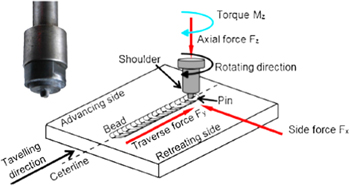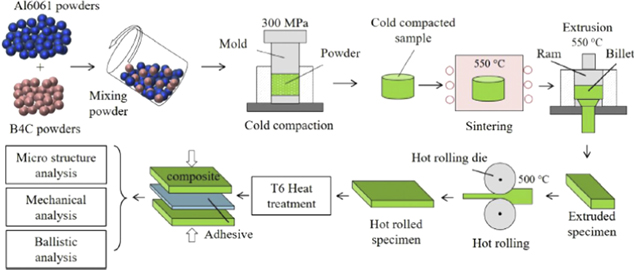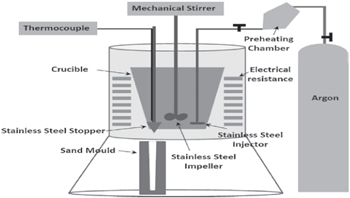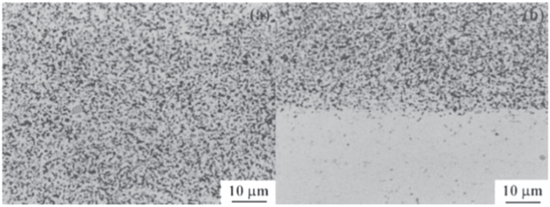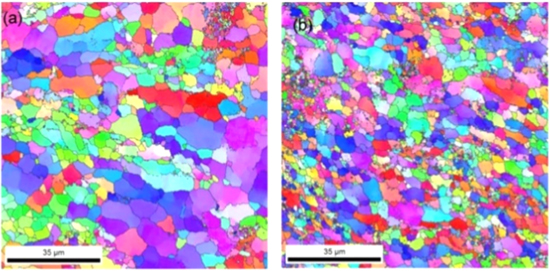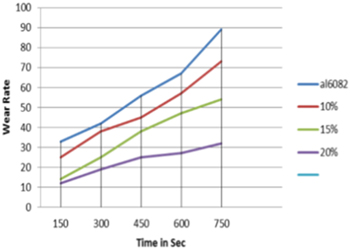Abstract
The current study focuses on the effect of the different ceramic reinforcement on the aluminium composite. The pros and cons of AMMCs are studied. In SiC reinforced composite's wear resistance, tensile strength and hardness will be improved, as it acts as an obstacle to the dislocation of atoms. B4C reinforced composites form more pores and agglomeration by the increase in B4C content however the hardness improves at the expense of ductility. TiC reinforced composite's interfacial bonding is good below 600 °C and the coefficient of thermal expansion reduces by increasing TiC weight percentage also mechanical properties like tensile and compressive strength improves. Al2O3 reinforcement will make grains finer hence adding Al2O3 improves the mechanical properties of the composite and it doesn't react with the matrix at high temperature. ZrO2 reinforcement will improve the hardness and wear resistance although primary wear happens due to micro-cutting and oxidation. As mentioned each reinforcement has both advantages and disadvantages, based on the application required reinforcement will be selected.
Export citation and abstract BibTeX RIS
In this modern world, there is an increase in demand for advanced materials to achieve preferred properties for the specific application. Composite materials are most preferred to achieve specific properties but their strength depends upon the composition of alloying elements added to the base material. The commonly used alloying elements are chromium, silicon, titanium, nickel, manganese, and magnesium. The other method of increasing the strength of aluminium is the incorporation of ceramic particulates, there has been significant growth in the research of aluminium alloys because about 70% of extruded products are made of aluminium. Aluminium Metal Matrix Composites [AMMC] are indispensable due to their elevated corrosion resistance, electrical and thermal conductivity, wear resistance, improved endurance, and lightweight properties. Hence AMMCs are tremendously used in aerospace, automobile, defense, electronics, and maritime industries for supporting structure, wing, fuselage, etc. 1 Aluminium has good mechanical and physical properties but it falls behind due to its high wear rate. This drawback can be overcome by incorporating ceramic particles and methods of producing composites. 2 Also, mechanical and physical properties can be enhanced by incorporating ceramic materials and processing the composite with a different technique.
Friction Stir Processing (FSP) is a modern and versatile method of surface modification technique that is environmentally friendly and energy-efficient. FSP of Aluminium alloys is a newly developed technique to increase their surface strength by refining their grain sizes. Moreover, the strength of an alloy can be increased if some reinforcement is added to an alloy. 3 There are wide ranges of applications of metal-matrix composite in today's World. It is studied that the refinement improves the wear resistance properties along with the load-bearing capacity of Al alloy. A metal-matrix composite (MMCs) consists of at least two components one being the metal and the other can be metal or any other organic compound. It is formed by reinforcing material into a metal matrix. The reinforcement can be either continuous or discontinuous. Figure 1 shows the friction stir process.
Figure 1. Friction stir processing. 4
Download figure:
Standard image High-resolution imageOn the other hand powder, metallurgy is the green and energy-saving process that offers complicated designs compare to other traditional manufacturing methods like spray casting, squeeze casting, compo casting, and stir casting. The process includes mixing of aluminium and reinforcement powders followed by cold compacting, sintering extrusion, and hot rolling as shown in Fig. 2. 5
Figure 2. Powder metallurgy process. 6
Download figure:
Standard image High-resolution imageAmong liquid metallurgy processing, the stir casting method is the most economical and popular technique used to produce a wide range of MMCs. This technique has various advantages, for example, better matrix particle bonding, the wide selection of materials, easier control of matrix structure, excellent productivity for near net-shaped components, and applicability to large quantity production. 7 Figure 3 shows the stir casting setup.
Figure 3. Stir casting process. 7
Download figure:
Standard image High-resolution imageIn the current study different ceramic particulates such as SiC, B4C, TiC, Al2O3, or ZrO2 reinforced with AMMC and processed by different methods such as friction stir process, powder metallurgy, or stir casting are considered and studied the influence of reinforcement and processing method on mechanical and physical properties of AMMC.
Methodology
SiC
Under abrasive and dry sliding condition it is observed that the improved wear resistance in aluminium based SiC reinforced composites with stir casting method 8,9 authors observed the problem with uniform distribution and formation of the cluster due to density difference, varied exposure timing between the molten Al and SiC particles creates poor wettability and elevated surface tension between them for that S Tzamtzis et al. 10 used a rheo casting method instead of directly introducing the reinforcement the author converted the state of liquid, the reinforcement introduced in the form of paste even then the problem of formation of the cluster is reduced but not eliminated, the grain refinement of the reinforcement is not uniform which affects the mechanical properties, other than these manufacturing process in solid-state processing is powder metallurgy process the uniform distribution of grains is observed 11,12 Sajjad Arif et al. 13 Studied on morphology and mechanical Aluminium-Silicon Carbide composite prepared by powder metallurgy technique. The study focuses on the worn-out surface morphology and analyzed the wear mechanism, and provides the information that an increase in SiC percentage will improve the wear resistance of the material, maximum wear resistance observed when 10% of SiC is added to composite beyond that wear resistance decreases. Mihir A Patel et al. 14 studied silicon carbide reinforced aluminium metal matrix composite by powder metallurgy technique and the study evidence that microhardness and density of the composites increase with the increase in SiC content. For 18 weight percentage (wt percentage) of silicon carbide reinforcement maximum value of 125HV noted compare to 10 and 15 wt percentage of silicon carbide but along with that the problem of decrease in ductility is also observed in aluminium based SiC composites this problem can be minimized by other processes called Friction stir processing by using FSP the grain reinforcement is equiaxed and fine grain are observed. 15–18 The presence of Al4C3 precipitate in the Al-SiC interface can form semi-coherent and orientation relationships between Al–SiC which has strong interfacial bonds.
Figure 4a refers to the uniform distribution of the SiC particles in Aluminium Metal Matrix Composites in FSP, nearly 27% of SiC particles exhibits has a volume fraction in Figs. 4a and 4b refer that perfect bonding appears between the reinforcement and the matrix. Mishra. R.S 15 studied the influence of SiC on AA6082 and studied the mechanical properties of Aluminium matrix composites produced by FSP. The five different kinds of passes were carried out aluminum workpieces without any processing as a reference plate and other passes with Sic respectively up to the third pass. It was found that the hardness value for the plate which was processed using maximum passes had maximum hardness value amongst all. This is due to the fine grain structure of the sample and that the wear rate decreases with an increase in the number of passes. The wear resistance improved with the addition of SiC reinforcements to the base alloy. Mishra R.S and Jeganathan et al. 16 studied the mechanical properties on AA6082/SiC MMC produced using FSP for the different number of passes, AA 6082 is also called structural alloy as it is well known for strength and stands top in the AA6000 series this is because of Mn which controls the grain structure. The author tested the specific wear rate, they observed that the specimen with SiC 3rd pass have a low wear rate compare to 1st pass with FSP and base metal. Al-based MMC will show a decrease in wear rate by increasing SiC reinforcement due to the obstacles to shear deformation by SiC. A general trend can be observed as the number of passes increases the wear rate decreases.
Figure 4. Optical microscope showing. (a) Uniform distribution of SiC particles. (b) Perfect bonding between matrix and reinforcement. 19
Download figure:
Standard image High-resolution imageB4C
Halil Karakoc et al. 6 studied ballistic and mechanical performances of Al6061 alloy reinforced with boron carbide by powder metallurgy technique. The study evidence that an increase in B4C weight % will improve the hardness, tensile strength, and ballistic behavior while fracture and impact toughness decreases for both hot extruded and hot-rolled composite as a result of radial cracks and spalling failure mechanism. E.Mohammad Sharifi et al. 20 studied on mechanical and wear properties of the composite produced from the powder metallurgy technique and the study evidence that hardness, compression, and wear test showed the optimum value for 15 weight % of B4C and those mechanical properties improves with an increase in B4C content which acts as the load-bearing element. The unreinforced Aluminium alloy is softer compared to reinforcement Al-B4C alloys which undergo plastic deformation which reduces the wear resistance. Oxidation and mechanical mixing are the main factors that control the wear mechanism in all the composites and also improves the wettability of the particles. Also mechanical mixing of layers that contain iron and oxygen plays a major role in the wear mechanism, if the thickness of the formed layer is more then the wear rate will be less and vice versa. The formation of this layer acts as a lubricant on the worn surface to reduce wear.
Figure 5 refers to the extent of the Metal Matrix Layer (MML) on the strained surface of 5, 10, and 15wt.% B4C samples are obtained by SEM reports has fig(a), fig(b), and fig (c) respectively. As the higher extent of MML constructively reduces the rate of wear. At a higher temperature than 450 °C prefers the formation of Al4BC transforms into Al3BC and AlB2 leads in high agglomerate grains, inferior strength, and interfacial properties to overcome hot rolling at 450 °C is performed.
Figure 5. Wear track of aluminium reinforced with (a) 5 wt.% (b) 10 wt.% (c) 15 wt.% B4C samples having Metal Matrix Layer (MML). 20
Download figure:
Standard image High-resolution imageTiC
Titanium carbide is the most preferable reinforcement due to its versatile properties like high elasticity, high hardness, and stiffness along with wear resistance property. 21 Compare to metal matrix composite the aluminium matrix has a good potential for high-temperature application. 22 A. Thangarasu et al. 22 studied the processing and characterization of AA 6082/ TiC, via the stir casting method, in this study he observed the distribution of the TiC because reinforcement density is higher than the matrix. Rajnesh Tyagi et al. 23 studied with in situ cast process of Al- TiC, the wear initially is because of oxidative layer, the layers are formed because of the compacted transfers of oxides which evidence an oxidative mechanism of wear and he observed the composite is following the Archad's law which states that linear increase in wear rate with an increase in load, but this method have its limitation only the particles which have inherently wetted by a matrix can be produced. K.B Lee et al. 24 analyzed the different reaction products formed at the interface of TiC and Al produced by infiltration, he observed that in water quench composite Al3Ti was barely observed, coarse grain results in a decrease in hardness, adding magnesium will improve the wettability property which reduces defects like pours and other crystal defects. T. Albert et al. 25 studied on characterization and preparation of titanium carbide (TiC) reinforced aluminium (Al) composite by powder metallurgy technique and provides the information that TiC and Al interfacial reaction are good below 600 °C hence strength and hardness of the composite will improve with an increase in TiC content. But the number of pores increases as density decreases due to heterogeneous structure of the Al and TiC due to the frittage at 550 °C in the meteorological furnace. M.Penchal Reddy et al. 26 studied the mechanical and thermal response of titanium carbide (TiC) reinforced aluminium composite by powder metallurgy technique and provides the information that young's modulus, tensile, yield strength, compressive strength, and nano-hardness significantly improves with an increase in TiC however the percentage of elongation and surface toughness declines. On progressive addition of titanium carbide to Al matrix will decrease the coefficient of thermal expansion (CTE), lowest CTE was found to be 2.1*10−6/K when 1.5 weight% reinforcement added. A.Thangarasu et al. 17 applied the friction stir processing method to synthesize AA6082/TiC AMCs to research the effect of TiC particles, their volume fraction on the microstructure, mechanical and sliding. The average size of TiC debris used in this work changed into 2 mm. FSP was processed on 5 plates varying the width of the groove (0, 0.2 up to1.6 mm) to have five levels of quantity fraction of TiC debris (0, 6, 12, 18, and 24 vol.%) interior of the microstructure, the location of AMC decreased because the quantity fraction extended, microstructures indicated that very satisfactory equiaxed grains were formed inside the base alloy appropriate to dynamic recrystallization at some point of FSP. Figure 6 refers to the distribution of TiC particles among the Al-Si matrix, some of the Al3Ti particles of needles in shape (remarked in arrow) are observed.
Figure 6. Distribution of Al3Ti in the Al matrix produced by in situ cast process. 23
Download figure:
Standard image High-resolution imageFigure 7 refers to the composites put through double and single-pass FSP respectively is observed under the EBSD technique. The equiaxed recrystallized grain structure of double pass FSP (4 μm) is better when compared with single-pass FSP (9 μm).
Figure 7. Refinement of grains and uniform distribution of Al-TiC produced by FSP. 21
Download figure:
Standard image High-resolution imageAl2O3
Ajith.S.dange et al. 27 studied the mechanical and wear properties of Al/Al2O3, by fluid metallurgy process method, utilizing blend throwing using short fibers of different volume fraction of 10, 15, and 20, he studied the trend of wear and hardness which is shown in the Figs. 8 and 9 respectively.
Figure 8. Graph of different percentages of reinforcement with 6082 hardness. 27
Download figure:
Standard image High-resolution imageFigure 9. Graph of different percentage of reinforcement with 6082, wear with time. 27
Download figure:
Standard image High-resolution imageHardness has been increased by increasing the reinforcement, but porosity also increases gradually which causes a decrease in other mechanical properties such as strength and stiffness, wear rate is increasing with the increase in load, and the impact of reinforcement concerning time and load. Ahmad et al. 28 study the impact of coating materials on the base materials, he observed the improvement of mechanical properties by surface modification of the materials. Josep A Picas et al. 29 studied the coating of different powders on Al substrate by high-velocity oxy-fuel coating, he observed some cracks on Al2O3 coated surface, even though the powder is uniformly coated by the dense structure of the powder is not showed the considerable mechanical properties instead that can be used for corrosion resistance element. One of the other methods which are most commonly used is powder coating in which fluidized bed is most widely used. G Rubino et 30 studied the heat treatment of AA6082 T6 Al with a layer formed by the fluidized bed in his study, he analyzed the improvement of the tribological and mechanical properties of the base metal by coating he analyzed the properties before and after heat treatment, the properties after heat treatment improved by the thickness of the coating is up to 10–15 μm. powder coating is a well-known process to improve the surface mechanical and tribological properties. 31–34 Mehdi Rahimian et al. 35 studied the influence of particle size and quantity on mechanical and microstructure properties of alumina (Al2O3) reinforced aluminium (Al) composite prepared using powder metallurgy technique. The study evidence that a decrease in particle size of Al2O3 will enhance the compressive strength, hardness, elongation and diminishes the wear resistance. While the increase in Al2O3 content will increase the yield and compressive strength up to 10 wt percentage of Al2O3 above that both of them will decrease but the elongation property of composite is exactly inversely proportional. wear rate will decrease on increasing Al2O3 content and the highest wear resistance found at 20 weight% among 0 to 20 weight% of Al2O3. A.Razzaqi et al. 36 studied on mechanical properties of alumina (Al2O3) reinforced aluminium composite by powder metallurgy technique and provides the information that up to 5% addition of Al2O3 improves the relative density, hardness, and tensile strength however greater than 5% of Al2O3 reinforcement decreases those properties. The addition of Al2O3 increases the yield and fracture stress yet ductility, stiffness, and toughness decrease. A.Shefiei-zarghani 18 performed this experiment intending to integrate nano-sized Al2O3 into AA6082 for comparison purposes a variety of numbers of FSP passes (one to four) were done with or without Al2O3 powder. Samples were subjected to different numbers of passes from one to four, with and without Al2O3 fine particles. After each pass, ambient air cooling was applied. Experimental analysis indicates that the rise in the amount of FSP proceeds on the specimen results in uniform distribution of nano-sized Al2O3 molecules. A fine distribution of Al2O3 molecules causes the splits of the molecules into each other nanocomposite layer is produced on the floor by four-way of FSP proceed. The nano-sized Al2O3 molecules are more effective in the reduction of grain size of the Al6082 metal matrix. It measures that the pinning result by the nano-sized Al2O3 molecules delays the grain expansion of the dynamically recrystallized grains of the Al metal matrix. The increase of the number of FSP proceed three times, it results in improvement of the microhardness of Al2O3 on the floor of nanocomposites compared to the as-received Al alloys. The growth of microhardness of Al/Al2O3 due to the presence of nano-sized Al2O3 molecules. Which contributes drastically to the strength via the Orowan mechanism. 15 As well as the ultra-fine grain size of the Al matrix. The wear resistance against the steel disk is drastically developed (two to three times) in Al/ Al2O3 floor of nanocomposite layer produced by four FSP proceed compared to the base metal of Al. The abrasive and adhesive are a combination of wear mechanism. The development of wear resistance for the floor composite layer is recognized to a lower coefficient of friction and improved hardness. The quantity part of the ceramic element was 18%. Most of the observation is similar as observed by 18 A. Shefiei-zarghani except some specific observations like the tribological and mechanical properties of AMCs are inclined by the nature of diffusion. The FSP practice has effects in pleasing homogenous diffusion while the aluminium matrix does not dissolve during FSP. The presence of gradient density does not allow the free moment of ceramic molecules. This results in high accuracy. The initial size and shape of molecules are important for the rate of fragmentation and results in the large molecular size of ceramics are not surrounded by refuse generated due to the fragmentation. There is no cluster in of tiny refuse either. This suggests that the refuse also varied well with the plasticized aluminium and diffuse homogeneously in the AMC. The size of refuse is extremely low in the order of nanometer compared to the size of, to begin with, packed ceramic molecules. The scale version results in functionally graded nearby regions in the AMC. There was no interfacial reaction between aluminium and any form of ceramic debris and right interfacial bonding turned into located.
ZrO2.
The most power full tool to produce an environmentally friendly coating is the sol-gel process which can replace the CCC coating with CAA. 37 Inorganic and organic hybrid constituents show an important functional material, where they find applications in wide-area like silver metallic reflectors utilized in laser cavities which are dip-coated with a hybrid silica-based defensive layer and in medical applications. 38 These coatings are called smart coatings because of the improved mechanical properties, 39 but the process has the limitations the electrical and optical property will be changed. 40 V S Smitha et al. 41 and her co-authors studied the hybrid nanocomposite and coating on Al alloy for corrosion resistance by the sol-gel method of coating for ORMOSIL-ZrO2 the base material used is AA6061 and the coating materials are methyltrimethoxsilane, (3-glycidyloxpropyin)- trimethoxy-silane and zirconium isopropoxide are used as a hybrid coating material. The author successfully coated the hybrid material on the Al by sol-gel process and observed the improved corrosion resistance properties. K. Sekar et al. 42 studied the mechanical and welding properties of Al/SiC/ZrO2 composite by stir and squeeze casting method, the author analyzed the composite in which the formation of the cluster in the material affects the mechanical properties and welding property to. N Yuvaraj et al. 43 investigated to study the effect of inserting different volume percent of ZrO2 reinforcement particles on the hardness and tribological characteristics of AA6082 alloy. This particle was chosen for the test because of its high melting point and excellent corrosion properties. In this different volume fraction of the powder is used by changing the dimension of the groove. The groove width sizes were taken to be 0 mm, 0.5 mm, 1.0 mm and 1.5 mm with 3 mm of depth to obtain volume fraction of particulate matter as 0%, 5%, 10%, and 15%. 44 The non-consumable tool used was made of H-13 hardened steel specimens were used to analyze dry sliding wear behavior on the pin on disc tribometer. M.Ramachandra et al. 45 studied wear resistance and hardness of zirconium dioxide (ZrO2) reinforced aluminium composite by powder metallurgy technique and provides the information that an increase in ZrO2 will improve the wear resistance and hardness. Predominant sliding wear mechanism in ZrO2 reinforced composite was micro-cutting and oxidation. In wettability of Al-ZrO2 alloy works on entrapment (firstly) and push way (secondly) mechanism is dominated over engulfment mechanism. The high temperature enhances the hardness, wettability, and in consequence composites, uniformity but other parameters such as interface weakening, pore formation, defect formation, and particle agglomeration look to be predominately at high temperature. Parveen, A. et al. 44 investigated the mechanical and tribological properties on Al-ZrO2 composites by powder metallurgy enhances the uniform distribution of reinforcement particles among Al matrix compared with the stir casting process. As the percentage of ZrO2 content increases which reduces the coefficient of friction enhances the wear resistance and consists of the least porosity due to the betterment of bonding between them.
Hybrid composite
Halil Karakoc et al. 46 studied the mechanical and tribological properties of aluminium/boron carbide/silicon carbide hybrid composite fabricated using powder metallurgy technique. The study focuses on the influence of SiC and B4C reinforcement on Al6061 hybrid composite and the study evidence that an increase in B4C content will improve the hardness at the expense of ductile property of composite while transverse rupture strength and tensile strength decreases. But increasing SiC content will improve the transverse rupture strength and tensile strength and the coefficient of friction will decrease. Due to the hardness of B4C and the good adherence property of SiC and matrix, the highest wear resistance was obtained at 3% SiC + 9% B4C. And the ductility and strength of the composite material decrease if the weight percentage of B4C content increases by more than 6%. Anil Kumar Bodukuri et al. 47 studied on mechanical properties of aluminium composite reinforced with boron carbide (B4C) and silicon carbide (SiC) fabricated using powder metallurgy and the study evidence that on the addition of 3% SiC and 7% B4C with aluminium metal matrix yields the hardness of 32.7 VHN also author states that on the addition of 25% of SiC into Al matrix will give the maximum impact strength of 36 N-m and hardness of 45.5 BHN. But on decreasing the wt percentage of B4C will reduce the hardness of the composite. Satish Babu Bopanna et al. 48 studied on characterization and fabrication of zirconium dioxide (ZrO2) and nanographene fortified Al6061 MMCs and the study evidence that the addition of ZrO2 and nanographene shows stronger packing and good bonding with the base material although few pores were observed. An increase in wt percentage of reinforcement will improve the ultimate tensile strength and yield strength however the percentage of elongation decreases. Sajjad Arif et al. 49 studied on mechanical and wear resistance properties of silicon carbide (SiC) and zirconium dioxide (ZrO2) reinforced aluminium MMC produced using powder metallurgy technique and the study evidence that property of the composite increase with an increase in ZrO2 0 wt percentage to 9 wt percentage due to agglomeration and low compressibility of powders however the hardness of the composite will be improved. Wear resistance of the composite improves with an increase in ZrO2 and high wear resistance found when 9% ZrO2 and 5% SiC are added to the metal matrix. Ehsan Ghasali et al. 50 studied on mechanical and microstructural properties of B4C and Co reinforced aluminium composite fabricated using powder metallurgy(microwave sintering) technique and the study evidence that bending strength, compressive strength, and micro-hardness improves with an increase in weight percentage of B4C and the maximum value was found at 850 °C sintering temperature. The density of composite increases up to 850 °C of sintering temperature after that density will decrease for all weight percentage.
Comparative Analysis
Table I. Comparative analysis of mechanical properties of Aluminium Metal Matrix Composites with different reinforcements.
| Process v/s reinforcement | Properties | SiC | B4C | TiC | Al2O3 | ZrO2 | Hybrid |
|---|---|---|---|---|---|---|---|
| Stir casting | Distribution of grains | Not uniform 9 | — | Fairly homogeneous (Al 6082) 22 | — | — | — |
| Wettability | Poor 9 | — | — | — | — | — | |
| Wear resistance | Increase (Al 6082) 8 | — | — | Increases 27 | Increases 42 | — | |
| Hardness | — | — | — | Increases 27 | Increases 42 | Increases 48 | |
| Strength and stiffness | Decreases (Al 6082) 27 | — | Increases (Al 6061) 48 | ||||
| Powder metallurgy | Distribution of grains | Uniform (Al 6082) 11,12 | — | — | — | — | — |
| Wear resistance | Increases (Al 1xxx) 13 | Increases (Al 1xxx) 20 | — | Increases 35 | Improved 41 | Increase (3% SiC + 9% B4C) 46 & 49 (9% ZrO2 + 5%SiC) | |
| Corrosion resistance | — | — | — | Increase (Al 2219,2024,7175) 30–35 | Improved 45 | — | |
| Hardness | Increases with increase in SiC 14 | Increases (Al 6061) 6 | Increases 25 | Increases 36 | Increases 45 | Increases 47,49 | |
| Ductility | Decreases 14 | — | — | Decreases 36 | — | Decreases (Al6061) 46 | |
| Tensile strength | — | Increases 6,20 | Increases 25,26 | Increases 36 | — | Increases 50 | |
| Compressive strength | — | Increases 20 | Increases 25 | Increases 35 | — | Increases 50 | |
| % of elongation | — | — | Decreases (Al 1xxx) 26 | Decreases 35 | — | — | |
| Ballistic strength | — | Increases 6 | — | — | — | Increases 47 | |
| Fracture and impact toughness | — | Decreases 6 | Decreases 26 | Decreases 36 | — | — | |
| Friction stir process | Grain distribution | Fine (Al 6082) 15–18,43 | — | — | Fine 18 | — | — |
| Wear resistance | Increases 15,16 | — | — | Increases 15 | — | — | |
| Micro—Hardness | Improves 15 | — | — | Increases 18 | — | — | |
| Damping capacity | — | — | — | — | — | — | |
| Tensile strength | — | — | Increases 15 | — | — |
Conclusions
Mechanical and tribological properties of composites were studied by adding ceramic reinforcement such as SiC, B4C, TiC, Al2O3, and ZrO2. It is observed that reinforcements and processing method significantly varied the properties of composites,
- Reinforcing SiC into the aluminium metal matrix (AMM) will improve the hardness and wear resistance of composite and the best results were found on adding 25% of SiC using powder metallurgy technique perhaps hardness of the composite has been improved by friction stir processing.
- Reinforcing B4C in AMM will improve the hardness and tensile strength yet reduces fracture toughness due to an increase in radial cracks and spalling failure mechanism. Although the optimum value of hardness, compression strength, and wear resistance is obtained for 15 wt. percentage of B4C. And those properties will further increase with the addition of more B4C content.
- Reinforcing TiC in AMM will improve hardness tensile and compression strength because of good interfacial bonding. The coefficient of thermal expansion of composite reduces on progressive addition of TiC (1.5 wt percentage). Uniform distribution of TiC is observed in FSP compare to other manufacturing processes, hence wear resistance increases predominantly by FSP.
- Reinforcing Al2O3 in AMM will improve hardness and wear resistance but elongation property decreases. Reducing the particle size of Al2O3 improves hardness, yield strength, compression strength, and elongation of the composite. A significant reduction in wear rate is observed on adding 20 wt. percentage Al2O3 content. The microhardness of the Al2O3 nanocomposite surface increases significantly with the increasing number of passes by FSP.
- Reinforcing ZrO2 in AMM will increase hardness and wear resistance and the maximum hardness obtained at 15 volume percentage of ZrO2. The hardness of the composite was improved by increasing the number of passes through FSP.
- Study evidence that hybrid composites possess good mechanical and tribological properties than aluminium alloy and single material reinforced composite. Composite made of Al6061/B4C/SiC shows good properties due to hardness of B4C and good adherence property of SiC and matrix, highest wear resistance obtained when 3% SiC + 9% B4C is added to AMM. In another hybrid composite addition of ZrO2 and nanographene shows stronger packing and good bonding with the base material hence high wear resistance was found in composite consisting of 9% ZrO2 + 3% SiC
Scope of future
Weight reduction plays an important role in the modern world due to the specific strength to weight ratio for aluminium and its alloys, there is a huge requirement to improve the lightweight materials. By adding different reinforcement to Aluminium Metal Matrix composites the mechanical properties and material properties can be improved.



